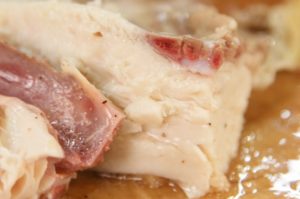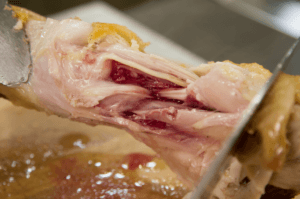what temp does chicken have to be at
Knowing the proper doneness temperatures when cooking chicken will ensure juicy results. Just what if the meat or juices are pink, and information technology looks bloody? If yous're similar many, the sight of anything but perfectly opaque meat with clear juices tin can brand you cringe when craven is on the menu.
Continue reading to find out what really causes this the pink color in chicken and how to be sure your family's chicken is truly rubber.
Food Condom is a Temperature, Non a Colour
Chicken meat cooks to a creamy-white colour—dissimilar the more robust hues of cooked beef, pork, or lamb. This white color provides a much starker contrast to the occasional pinkish tones that can naturally occur in whatsoever meat.
Dr. O. Peter Snyder, Jr., Ph.D. of the Hospitality Institute of Technology and Direction says, "If consumers were taught to swallow safely prepared, bloody chicken, as they want to do with beef, they would be able to relish juicier chicken." The trick is to acquire how to set safe-to-consume chicken and get over our fearfulness of a little blood in our birds.
So, how do you know for certain if your chicken is rubber to eat? One word: temperature.
Overcorrecting with Overcooking
Mayhap one reason society is more accepting of reddish and pinkish hues in steaks is that beefiness can be safely cooked to varying degrees of doneness. Chicken, on the other hand, is either prophylactic to consume or it's non. There is no such matter equally medium-rare chicken. Nevertheless, too many cooks overcook their chicken for fear of undercooking it. Overcooked chicken is just like overcooked beef: dry out, tough, and less flavorful than properly-cooked meat
Regardless of the type of meat beingness cooked, the higher the doneness temperature, the more than juices will be lost and the less tender the results will be. Properly gauging the internal temperature of meats, including chicken, is the just style to guarantee safe and juicy results every single time.
Internal Temperatures for Doneness and Eating Quality of Chicken
➤ 165°F
What is and then magical about 165°F (74°C)? At 165°F (74°C) all foodborne bacteria are destroyed instantly. This instant death for foodborne pathogens is recommended for poultry because even the most stubborn salmonella bacteria will be completely pasteurized at this temperature. Even if a slow, depression-accuracy dial thermometer is off by every bit much as 10°F (six°C), a final cooked temperature of 155°F (68°C) in chicken volition only need to stay at that temperature for merely under 60 seconds in order for the meat to exist prophylactic. (Does that sound like it goes confronting everything y'all've ever learned near chicken safety? If and then, you might need to read our complete guide to craven temps to brush upwards on the nuances of bacterial kill times.)
➤ 170°F and Higher for Nighttime Meat
Leg and thigh meat is still safe at 165°F, only information technology is recommended to melt it to an internal temperature of about170-175°F (77-79°C). The chicken's legs are actively worked muscles, and the meat is tougher because of information technology.

The leg pictured to the right was cooked to the recommended range of 170-175°F (77-79°C) (every bit verified with a Thermapen® ONE). Leg meat needs to be cooked to higher temperatures than the leaner and more than delicate breast meat because information technology contains more connective tissue that needs time at loftier temps to deliquesce properly. This higher temperature will ensure that the dark meat becomes tender and juicy. Even at this higher temperature, the meat still appeared quite pinkish.
Mutual Myth: "Craven is Washed When the Juices Run Clear"
One mutual just inaccurate method of verifying the doneness of chicken is to cut into the meat and watch to be sure all of the juices are running clear. When probing craven over the grill or in the oven, we sometimes expect for anything pink in the meat as a clear indication that its non even so properly cooked. The fact of the matter is that depending upon where you probe your chicken, the color of the meat or juices may never be free of pinkish, red, or even majestic tones.
So why does chicken so often announced undercooked?
Why Cooked Craven Tin Still Exist Pink
Reason 1: Young Chickens

The chickens available at grocery stores that we purchase are usually between 6 and 8 weeks of historic period. These young chickens aren't still fully mature, and their basic are porous rather than completely calcified. The bone marrow within of craven bones is purplish and tin ofttimes permeate through soft, porous chicken bones (pictured at correct).
The liquid independent in the mass of a chicken expands during freezing, including the bone marrow. The nighttime marrow can push through the bone'southward surface as information technology expands. The bones and meat next to them get stained, and will remain a deep red/purple color regardless of the final internal temperature of the cooked craven.
Reason 2: Myoglobin

Myoglobin is some other culprit for the purple and red colors found in poultry. Information technology is a richly pigmented protein that delivers oxygen to cells to muscle fibers. The more active an animal is, the more than oxygen is contained in their muscle, giving it a darker color.
Chickens are flightless birds, so the breast meat is never heavily oxygenated. Low levels of myoglobin are why chicken breasts have such fragile white flesh. The heavily worked legs take darker meat considering of higher levels of myoglobin.
While chicken is packaged and readied for purchase in a grocery shop, myoglobin tin tend to pool in the meat fibers.
Reason 3: pH Levels
The acerbity of the meat can affect its colour, too. The higher the pH level (lower acidity), the pinker the meat will be. This is why some chefs use an acidic marinade with citrus or vinegar to aid reduce pink colors in chicken meat. Simply marinades volition practice lilliputian to protect against tinges of pink from marrow and myoglobin.
Eat Pink Chicken Confidently
Now that y'all know why your chicken can sometimes be pink, it's fourth dimension to eat craven more confidently. Near importantly, stop overcooking your chicken!
Armed with an accurate thermometer like the Thermapen, you tin verify the safety and quality of your chicken—regardless of its color. A probe inserted into the thermal center of a craven breast, leg, or thigh should read165°F (74°C)when it's time to consume.
(Thanks to AmazingRibs.com for the inspiration for this article.)
Shop at present for products used in this post:

Source: https://blog.thermoworks.com/chicken/bloody_chicken/

0 Response to "what temp does chicken have to be at"
Post a Comment